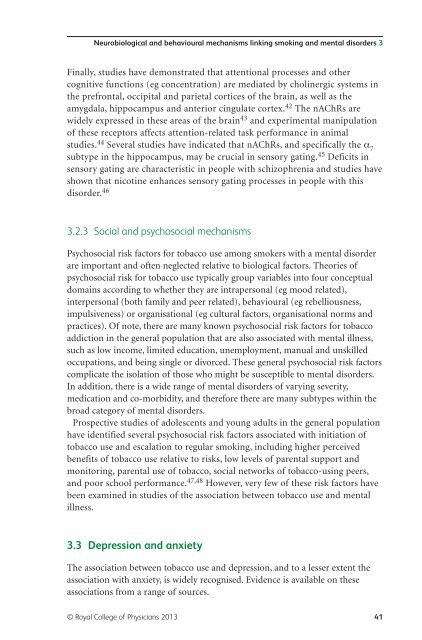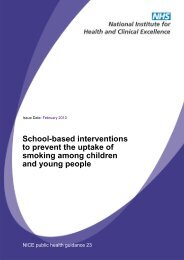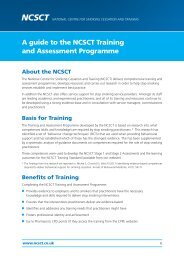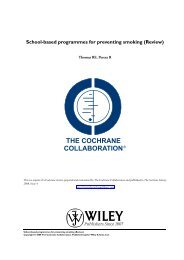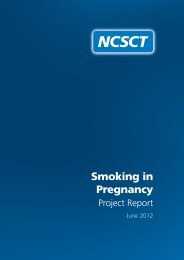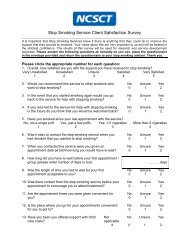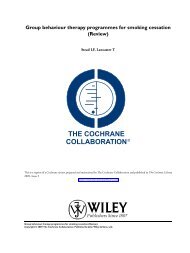Smoking and mental health - NCSCT
Smoking and mental health - NCSCT
Smoking and mental health - NCSCT
Create successful ePaper yourself
Turn your PDF publications into a flip-book with our unique Google optimized e-Paper software.
Neurobiological <strong>and</strong> behavioural mechanisms linking smoking <strong>and</strong> <strong>mental</strong> disorders 3<br />
Finally, studies have demonstrated that attentional processes <strong>and</strong> other<br />
cognitive functions (eg concentration) are mediated by cholinergic systems in<br />
the prefrontal, occipital <strong>and</strong> parietal cortices of the brain, as well as the<br />
amygdala, hippocampus <strong>and</strong> anterior cingulate cortex. 42 The nAChRs are<br />
widely expressed in these areas of the brain 43 <strong>and</strong> experi<strong>mental</strong> manipulation<br />
of these receptors affects attention-related task performance in animal<br />
studies. 44 Several studies have indicated that nAChRs, <strong>and</strong> specifically the α 7<br />
subtype in the hippocampus, may be crucial in sensory gating. 45 Deficits in<br />
sensory gating are characteristic in people with schizophrenia <strong>and</strong> studies have<br />
shown that nicotine enhances sensory gating processes in people with this<br />
disorder. 46<br />
3.2.3 Social <strong>and</strong> psychosocial mechanisms<br />
Psychosocial risk factors for tobacco use among smokers with a <strong>mental</strong> disorder<br />
are important <strong>and</strong> often neglected relative to biological factors. Theories of<br />
psychosocial risk for tobacco use typically group variables into four conceptual<br />
domains according to whether they are intrapersonal (eg mood related),<br />
interpersonal (both family <strong>and</strong> peer related), behavioural (eg rebelliousness,<br />
impulsiveness) or organisational (eg cultural factors, organisational norms <strong>and</strong><br />
practices). Of note, there are many known psychosocial risk factors for tobacco<br />
addiction in the general population that are also associated with <strong>mental</strong> illness,<br />
such as low income, limited education, unemployment, manual <strong>and</strong> unskilled<br />
occupations, <strong>and</strong> being single or divorced. These general psychosocial risk factors<br />
complicate the isolation of those who might be susceptible to <strong>mental</strong> disorders.<br />
In addition, there is a wide range of <strong>mental</strong> disorders of varying severity,<br />
medication <strong>and</strong> co-morbidity, <strong>and</strong> therefore there are many subtypes within the<br />
broad category of <strong>mental</strong> disorders.<br />
Prospective studies of adolescents <strong>and</strong> young adults in the general population<br />
have identified several psychosocial risk factors associated with initiation of<br />
tobacco use <strong>and</strong> escalation to regular smoking, including higher perceived<br />
benefits of tobacco use relative to risks, low levels of parental support <strong>and</strong><br />
monitoring, parental use of tobacco, social networks of tobacco-using peers,<br />
<strong>and</strong> poor school performance. 47,48 However, very few of these risk factors have<br />
been examined in studies of the association between tobacco use <strong>and</strong> <strong>mental</strong><br />
illness.<br />
3.3 Depression <strong>and</strong> anxiety<br />
The association between tobacco use <strong>and</strong> depression, <strong>and</strong> to a lesser extent the<br />
association with anxiety, is widely recognised. Evidence is available on these<br />
associations from a range of sources.<br />
© Royal College of Physicians 2013 41


